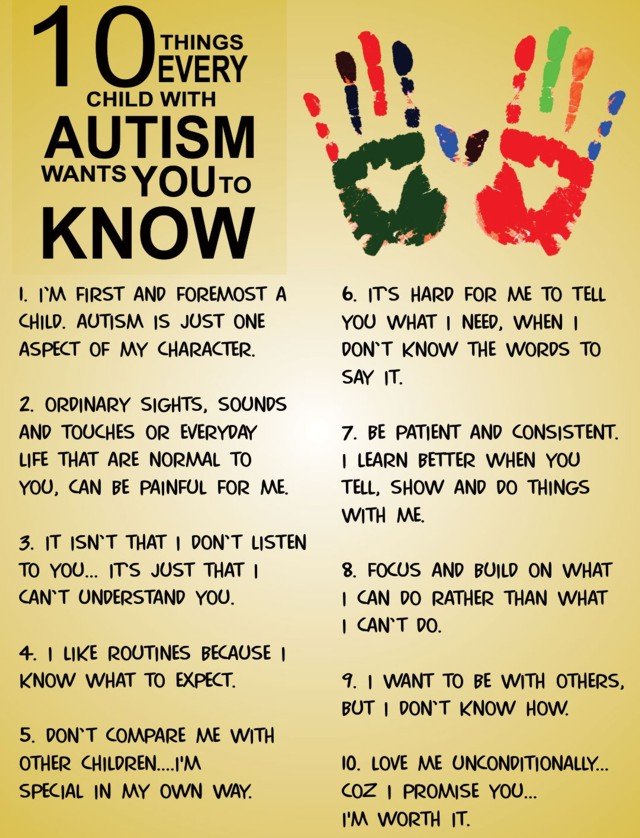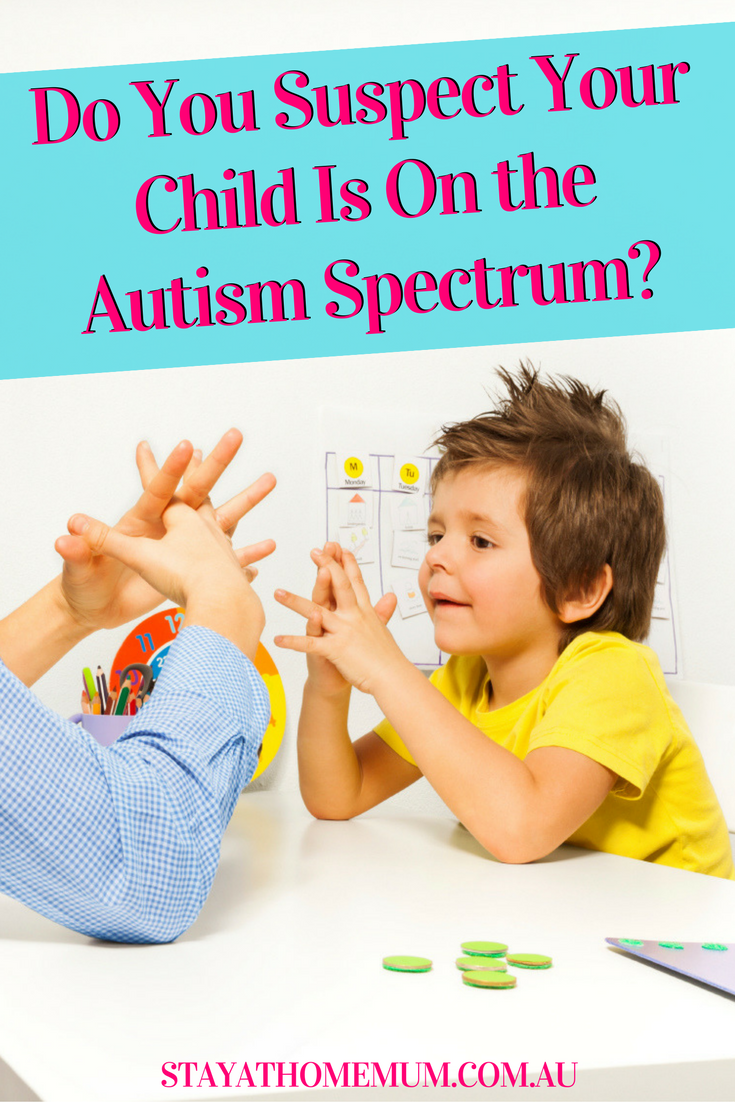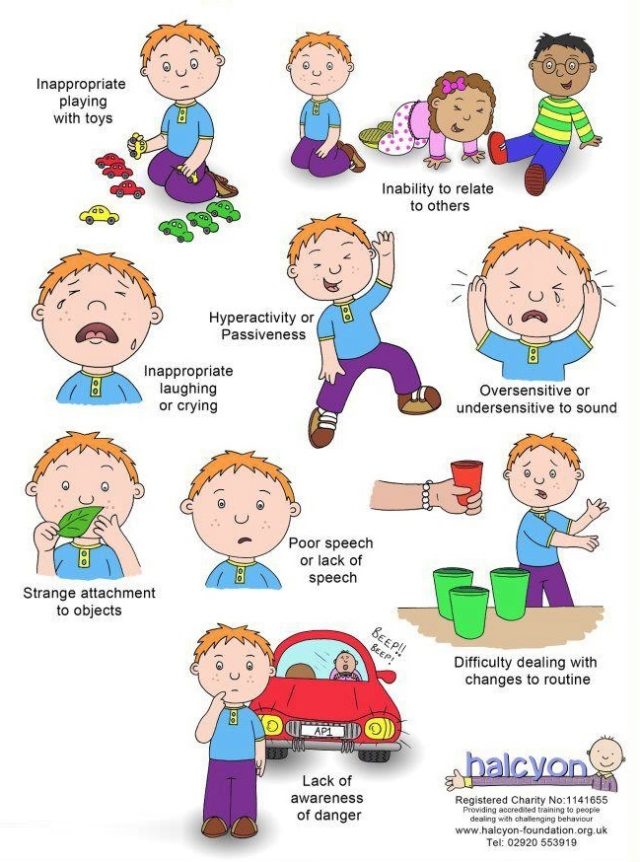Language And Communication Skills
An autistic child who needs more support in developing language and communication skills may exhibit some of these signs:
- cannot form sentences
- does not answer questions appropriately or follow directions
- does not understand counting or time
- reverses pronouns
- rarely or never uses gestures or body language such as waving or pointing
- talks in a flat or singsong voice
- does not understand jokes, sarcasm, or teasing
Answer The Five Questions At The End Of This Post And If You Answer No To Two Or More Begin Early Intervention Right Away But First Here Are Some Early Warning Signs Of Asd
Early Warning Signs: First Year
Even young infants are very social, so its possible to detect signs of autism in how babies interact with their world. At this age, a child with an ASD may:
- Not turn to a mothers voice
- Not respond to his own name
- Not look people in the eye
- Have no babbling or pointing by age one
- Not smile or respond to social cues from others
Babies who do not have autism can have these behaviors, too, but it’s best to contact your doctor right away with any concerns.
At 12 Months
- A child with typical development will turn his head when he hears his name.
- A child with ASD might not turn to look, even after his name is repeated several times, but will respond to other sounds.
At 18 Months
- A child with delayed speech skills will point, gesture, or use facial expressions to make up for her lack of talking.
- A child with ASD might make no attempt to compensate for delayed speech or might limit speech to parroting what is heard on TV or what she just heard.
At 24 Months
- A child with typical development brings a picture to show his mother and shares his joy from it with her.
- A child with ASD might bring her a bottle of bubbles to open, but he does not look at his mom’s face when she does or share in the pleasure of playing together.
ASD at any age might include the following signs:
- Repeated motions
- Avoiding eye contact or physical touch
- Delays in learning to talk
- Repeating words or phrases
- Getting upset by minor changes
Prenatal Factors That May Contribute To Autism
Taking antidepressants during pregnancy, especially in the first 3 months.
Nutritional deficiencies early in pregnancy, particularly not getting enough folic acid.
The age of the mother and father
Complications at or shortly after birth, including very low birth weight and neonatal anemia
Maternal infections during pregnancy.
Exposure to chemical pollutants, such as metals and pesticides, while pregnant.
More research on these prenatal risk factors is needed, but if youre pregnant or trying to conceive, it cant hurt to take steps now to reduce your babys risk of autism.
Reducing the risk of autism: Tips for expectant mothers
Take a multivitamin. Taking 400 micrograms of folic acid daily helps prevent birth defects such as spina bifida. Its not clear whether this will also help reduce risk of autism, but taking the vitamins cant hurt.
Ask about SSRIs. Women who are taking an SSRI should talk with a clinician about all the risks and benefits of these drugs. Untreated depression in a mother can also affect her childs well-being later on, so this is not a simple decision to make.
Practice prenatal care. Eating nutritious food, trying to avoid infections, and seeing a clinician for regular check-ups can increase the chances of giving birth to a healthy child.
Source: Harvard Health Publications
Also Check: What Does Autism Look Like In Girls
Screening And Diagnosis Of Autism Spectrum Disorder
Diagnosing autism spectrum disorder can be difficult because there is no medical test, like a blood test, to diagnose the disorder. Doctors look at the childs developmental history and behavior to make a diagnosis.
ASD can sometimes be detected at 18 months or younger. By age 2, a diagnosis by an experienced professional can be considered very reliable . However, many children do not receive a final diagnosis until much older. Some people are not diagnosed until they are adolescents or adults. This delay means that children with ASD might not get the early help they need.
Early signs of ASD can include, but are not limited to
- Avoiding eye contact,
- Having little interest in other children or caretakers,
- Limited display of language , or
- Getting upset by minor changes in routine.
CDCs Learn the Signs. Act Early. program provides free resources to help families monitor developmental milestones and recognize signs of developmental concerns, including ASD.
As children with ASD become adolescents and young adults, they might have difficulties developing and maintaining friendships, communicating with peers and adults, or understanding what behaviors are expected in school or on the job. They may also come to the attention of healthcare providers because they have co-occurring conditions such as attention-deficit/hyperactivity disorder, obsessive compulsive disorder, anxiety or depression, or conduct disorder.
May Have No Interest In Interacting With The World Around Them

For the neurotypical child, the world is full of bizarre and wonderful things that they have never seen or encountered before things that naturally pique their curiosity and draw them in. The normal response to a new experience or discovery is typically wide-eyed wonderment, dismay, amusement and inquisitiveness.
Children with ASD respond to the world very differently. You might notice that your child doesnt really respond with eye contact or normal outward signs of curiosity when you try to get their attention. Perhaps they dont even turn their head in your direction when you say their name. They might not point at objects, show a normal level of curiosity, or attempt to engage you by showing you their toys and drawings in an effort to share their interests and elicit a positive response.
A lack of responsiveness to stimuli and a lack of interest in trying to seek parental attention is a pretty common sign that a child may fall somewhere on the spectrum.
Children typically learn through imitation. Even at an early age, the neurotypical child will begin copying adult behaviorsyou might catch them pretending to cook, holding an object up to their ear as if they are talking on the phone, or pretending to feed and care for a doll.
Children on the spectrum may also have adverse reactions to normal physical contact, such as a hug, holding hands, or being picked up off the floor and held.
Don’t Miss: Can A Child Outgrow Autism
A Lack Of Interest In Pretend Play
For kids with autism, pretend skills may be absent or lacking. dont use objects for pretend playstuff like picking up a sponge and using it as a pretend phone, she says. Play-feeding a doll or pretending the couch is a truck or train are other examples. If this kind of pretend play hasnt started by 18 months, thats a warning sign, notes the CDC.
Behaviour: Early Signs Of Autism
Repetitive and restricted interests If young children are autistic, they might:
- have an intense interest in certain objects and get stuck on particular toys or objects for example, theyll flick the light switch off and on repeatedly, or play only with cars or dolls
- interact with toys and objects in limited ways for example, they might mainly spin the wheels of a toy car rather than pretending to drive the car along the floor, or take the clothes on and off a doll repeatedly
- be very interested in certain objects or activities and get upset if they cant do that activity for example, watching the same TV show over and over
- focus narrowly on objects and activities, like lining up objects or putting toys into a pile.
RoutinesIf young children are autistic, they might be easily upset by change and need to follow routines. For example, they might need to follow the same route to child care or a grandparents house every time.
Repetitive movementsIf young children are autistic, they might repeat body movements or have unusual body movements, like back-arching, hand-flapping, arm-stiffening and walking on the tips of their toes.
Sensory sensitivitiesIf young children are autistic, they might:
If youd like to check your childs behaviour and development for early signs of autism, you can download ASDetect a free, evidence-based, app developed by La Trobe University and suitable for use with children aged 11-30 months.
Also Check: What Is The Symbol For Autism
Repetitive Or Restrictive Behaviors
An autistic child who has adopted certain repetitive or restrictive behaviors may exhibit some of these signs:
- performs repetitive motions, such as flapping their hands, rocking back and forth, or spinning
- persistently or repeatedly lines up toys or other objects in an organized fashion
- gets upset or frustrated by small changes in their daily routine
- has to follow certain routines
- plays with toys the same way every time
- likes certain parts of objects
- has obsessive interests
What Should I Do If My Child Is Showing Symptoms Of Autism
Call your pediatrician or your state’s Early Intervention program to schedule an appointment for a formal autism screening. From there, you may be referred to a specialist for a full diagnostic evaluation.
Before your child’s screening, you may find it helpful to fill out the M-CHAT, which stands for Modified Checklist for Autism in Toddlers and is an American Academy of Pediatrics-approved screening tool for autism. Print out your results and bring them with you to discuss with your child’s doctor.
Don’t Miss: Link Between Gestational Diabetes And Autism
What Is High Functioning Autism
High functioning autism describes one with autism without an intellectual disability. However, people with high functioning autism have deficits in certain areas including communication, emotion, recognition, expression, and social interaction.
Another common name for high functioning autism is mild autism or Aspergers syndrome . Although term Aspergers syndrome is no longer used as an official diagnosis.
Today, these people are diagnosed with either high functioning autism or autism level 1.
Autism Signs By 3 Months
- She doesn’t follow moving objects with her eyes: Babies at high risk for autism dont follow caregivers as they move in the visual field, says Dr. Frazier. They may be more intrigued by something like a blanket.
- She doesn’t respond to loud noises.
-
She doesn’t grasp and hold objects.
-
She doesn’t pay attention to new faces
You May Like: Do Autistic Toddlers Dance
Communication Differences In Children With Autism
-Less likely to point at things to indicate needs or share things with others-Says no single words by 15 months or 2-word phrases by 24 months-Repeats exactly what others say without understanding the meaning -May not respond to name being called but does respond to other sounds -May refers to self as you and others as I and may mix up pronouns-May show no or less interest in communicating-Less likely to start or continue a conversation-Less likely to use toys or other objects to represent people or real life in pretend play-May have a good rote memory, especially for numbers, letters, songs, TV jingles, or a specific topic-May lose language or other social milestones, usually between the ages of 15 and 24 months
Early Signs Of Autism In A 2 Year Old

If you feel like your 2-year-old doesnt seem to be catching up with their development milestones, you may start looking for certain signs of autism spectrum disorder for any delays.Mild symptoms can be mistaken for being shy or the terrible twos.
Here are some red flags that may indicate ASD:
- Doesnt speak more than 15 words,
- Cant walk ,
- Doesnt know functions of household items like fork,
- Doesnt imitate parents actions or words,
- Doesnt use items for their own purposes,
- Doesnt follow simple instructions
Read Also: Does Nick Eh 30 Have Autism
Early Signs Of Autism In Babies Aged 0
Shortly after they are born, babies begin to smile and coo at people around them. By the time they turn 2 months old, they are able to pay attention to faces.
If the child has autism spectrum disorder, this may not be the case. If a child doesnt smile, or smile as big, and is not showing any warm expression, it may be a sign of autism spectrum disorder.
The following signs can also be seen by the time the baby turns 3 months old:
- Doesnt respond to loud noises,
- Doesnt grasp objects,
- Doesnt follow objects with their eyes,
- Doesnt babble,
- Doesnt point to things,
- Doesnt respond to their names,
- Cant stand when supported,
- Doesnt babble
Free Autism Signs Printable Cheat Sheet
I know that we just covered a TON of information, and I want to make sure that you have a simple way to check the important signs that your child may be autistic, so I created a free printable cheat sheet just for you!
With all of the signs listed and broken up by category, you can easily use this and highlight those that fit your child.
Bring this to the pediatricians office, your IEP meeting, or to a therapy evaluation so that you have a visual reminder of what youve noticed at home with your child.
To , you just need to click the image below, answer a few super simple questions and your cheat sheet will hit your email in no time!
About Kaylene
Don’t Miss: Can A Child With Autism Have Dyslexia
Differences Between Mild And Severe Symptoms
Autism disorders fall along a spectrum of mild to severe. Some children with ASD have advanced learning and problem-solving skills, while others require daily living assistance.
According to the American Psychiatric Associations diagnostic criteria, there are three levels of autism that are defined by how much support a person requires.
What Are The Next Steps
Signs of autism are usually evident by 4 years old. If youve noticed signs of autism in your child, its important to talk with their doctor to get them screened as soon as possible.
You can start by going to their pediatrician to explain your concerns. The pediatrician can give you a referral to a specialist in your area.
Specialists who can diagnose autism in children include:
- developmental pediatricians
Recommended Reading: Symbol For Autism
Signs And Symptoms Of Autism Spectrum Disorders
Autism spectrum disorder is a developmental disability caused by differences in the brain. Some people with ASD have a known difference, such as a genetic condition. Other causes are not yet known. Scientists believe there are multiple causes of ASD that act together to change the most common ways people develop. We still have much to learn about these causes and how they impact people with ASD.
There is often nothing about how people with ASD look that sets them apart from other people. They may behave, communicate, interact, and learn in ways that are different from most other people. The abilities of people with ASD can vary significantly. For example, some people with ASD may have advanced conversation skills whereas others may be nonverbal. Some people with ASD need a lot of help in their daily lives others can work and live with little to no support.
ASD begins before the age of 3 years and can last throughout a persons life, although symptoms may improve over time. Some children show ASD symptoms within the first 12 months of life. In others, symptoms may not show up until 24 months or later. Some children with ASD gain new skills and meet developmental milestones, until around 18 to 24 months of age and then they stop gaining new skills, or they lose the skills they once had.
Can A Child Be Slightly Autistic
A child can be mildly autistic. Every child with autism spectrum disorder is unique and so symptoms may differ in severity and range between individuals. Children diagnosed as mildly autistic are unable to understand the body language or emotions of the people around them, but they do have normal intelligence and can conduct their daily activities.
Read Also: Freddie Highmore Really Autistic
Behavioural Signs In Infants Between 6 And 12 Months Can Predict Asd
A 2005 Canadian study published in the International Journal of Developmental Neuroscience, with over 200 participants was the first to pinpoint specific behavioural signs in infants as young as 12 months that can predict, with remarkable accuracy, whether a child will develop autism.
Autism is one of the most prevalent disorders today, and while a bio marker was finally found last year to help with early diagnosis, its normally only 80% effective, and so far mostly being used on higher risk infants. Also it is found using an MRI, and wait times can be long. Most doctors instead must rely on parent observations, observing the child themselves, and using standardized tools like the Checklist for Autism in Toddlers . However these tools are made for children who are 18 months and older, a long time especially when early detection and intervention can help with many of the frustrations that develop from communication problems.
Because of the research done, a scale was developed to help doctors with early assessment in infants as young as 6 months . The Autism Observation Scale for Infants has been a fantastic new tool to help parents and doctors get an early diagnosis.
What Are The Signs Of Asd In Babies

Diagnosing ASD is challenging. One reason for this is that the condition presents differently in all individuals.
Babies can reach developmental milestones at slightly different ages, even when they do not have any health conditions. However, some developmental differences indicate that a baby may be autistic. These include:
You May Like: What Are Good Toys For Autistic Toddlers